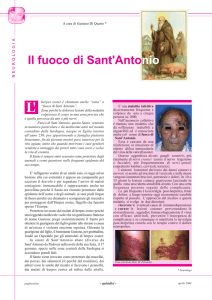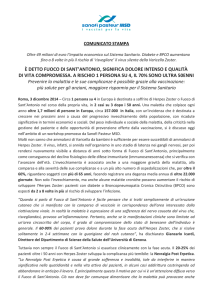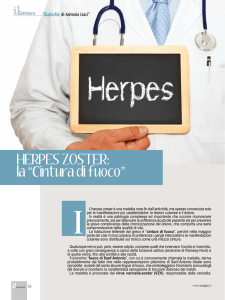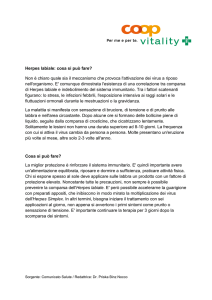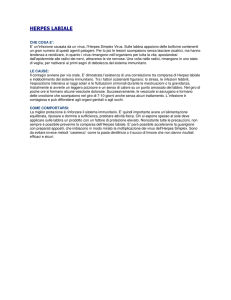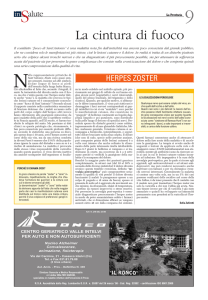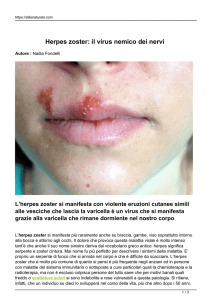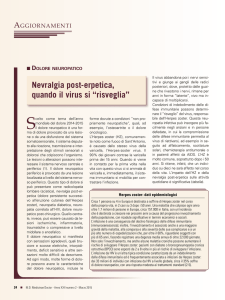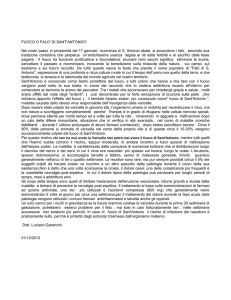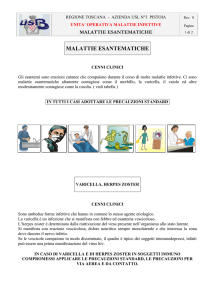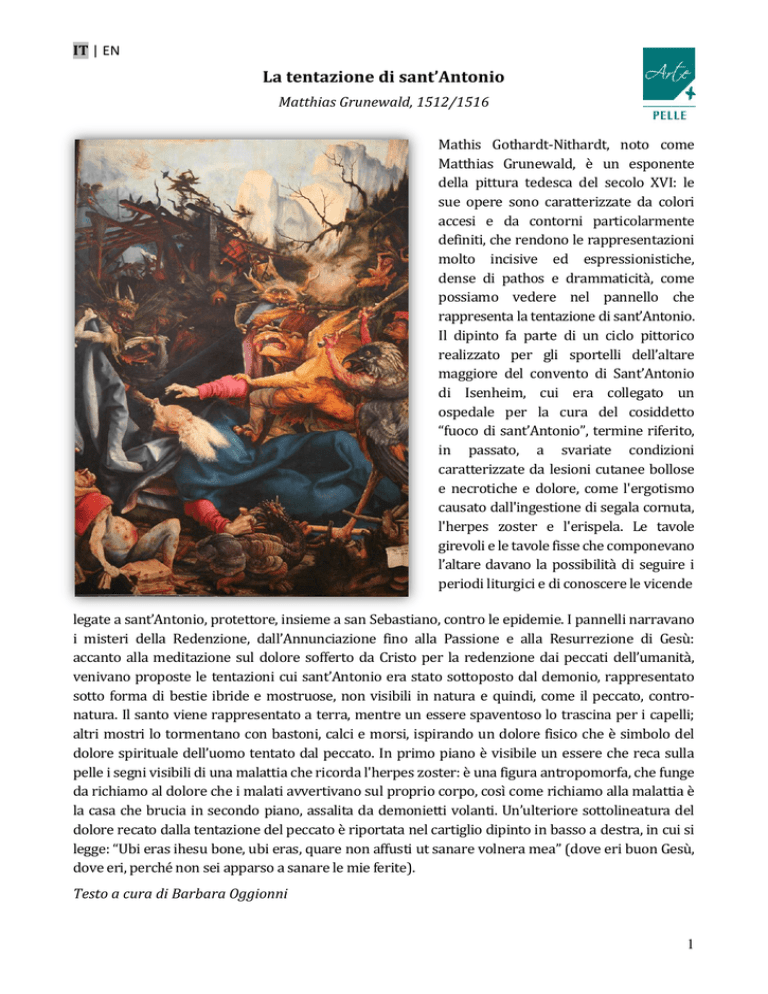
IT | EN
La tentazione di sant’Antonio
Matthias Grunewald, 1512/1516
Mathis Gothardt-Nithardt, noto come
Matthias Grunewald, è un esponente
della pittura tedesca del secolo XVI: le
sue opere sono caratterizzate da colori
accesi e da contorni particolarmente
definiti, che rendono le rappresentazioni
molto incisive ed espressionistiche,
dense di pathos e drammaticità, come
possiamo vedere nel pannello che
rappresenta la tentazione di sant’Antonio.
Il dipinto fa parte di un ciclo pittorico
realizzato per gli sportelli dell’altare
maggiore del convento di Sant’Antonio
di Isenheim, cui era collegato un
ospedale per la cura del cosiddetto
“fuoco di sant’Antonio”, termine riferito,
in passato, a svariate condizioni
caratterizzate da lesioni cutanee bollose
e necrotiche e dolore, come l'ergotismo
causato dall'ingestione di segala cornuta,
l'herpes zoster e l'erispela. Le tavole
girevoli e le tavole fisse che componevano
l’altare davano la possibilità di seguire i
periodi liturgici e di conoscere le vicende
legate a sant’Antonio, protettore, insieme a san Sebastiano, contro le epidemie. I pannelli narravano
i misteri della Redenzione, dall’Annunciazione fino alla Passione e alla Resurrezione di Gesù:
accanto alla meditazione sul dolore sofferto da Cristo per la redenzione dai peccati dell’umanità,
venivano proposte le tentazioni cui sant’Antonio era stato sottoposto dal demonio, rappresentato
sotto forma di bestie ibride e mostruose, non visibili in natura e quindi, come il peccato, contronatura. Il santo viene rappresentato a terra, mentre un essere spaventoso lo trascina per i capelli;
altri mostri lo tormentano con bastoni, calci e morsi, ispirando un dolore fisico che è simbolo del
dolore spirituale dell’uomo tentato dal peccato. In primo piano è visibile un essere che reca sulla
pelle i segni visibili di una malattia che ricorda l'herpes zoster: è una figura antropomorfa, che funge
da richiamo al dolore che i malati avvertivano sul proprio corpo, così come richiamo alla malattia è
la casa che brucia in secondo piano, assalita da demonietti volanti. Un’ulteriore sottolineatura del
dolore recato dalla tentazione del peccato è riportata nel cartiglio dipinto in basso a destra, in cui si
legge: “Ubi eras ihesu bone, ubi eras, quare non affusti ut sanare volnera mea” (dove eri buon Gesù,
dove eri, perché non sei apparso a sanare le mie ferite).
Testo a cura di Barbara Oggionni
1
IT | EN
Herpes zoster
Sant’Antonio Abate eremita egiziano vissuto attorno al 300
d.C. fu trovato nel deserto dai suoi discepoli privo di
coscienza e coperto di piaghe ed ustioni. La storia racconta
che tali ustioni furono provocate dal diavolo che venne a
tentarlo e a cui il Santo resistette dominando le tentazioni
del demonio e le fiamme dell’inferno. Da allora il nome di
Sant’Antonio venne associato a tutte le malattie che
provocano dolore e bruciore intenso. In Italia il “Fuoco di
Sant’Antonio” è per antonomasia l'herpes zoster, causato
dall'herpes virus di tipo 3 o virus della varicella-zoster. Nei
secoli passati furono identificate con il termine di “Fuoco di
Sant’Antonio” anche altre malattie accomunate dal fatto di
manifestarsi con lesioni cutanee dolenti e tendenza
all’ulcerazione e alla gangrena. In particolare veniva associato
al “fuoco di Sant’Antonio” l’ergotismo, un’intossicazione
alimentare legata all’ingestione di alimenti preparati con farina
di segale alterata dalla presenza del fungo Claviceps
purpurea (segale cornuta) che nel lontano passato ha
mietuto numerose vittime.
L’Herpes Zoster si manifesta con dolori nevralgici che
iniziano poco prima o insieme alla comparsa di vescicole
sulla pelle. Le vescicole che tendono a confluire tra di loro si
presentano con una distribuzione a fascia nel territorio di
innervazione di un ganglio sensitivo; pertanto la malattia è
spesso monolaterale e distribuita su un’area cutanea
circoscritta. Il termine Zoster deriva dal greco e significa
proprio cintura, fascia. L’herpes zoster è causato dalla
riattivazione del virus della varicella-zoster che dopo
l’infezione primaria, la varicella, rimane latente all’interno
dei gangli nervosi dei nervi cranici e del midollo spinale.
Riattivandosi, il virus torna a moltiplicarsi e si propaga
attraverso i nervi fino alla cute o alle mucose causando la
comparsa delle caratteristiche lesioni. La malattia è spesso
accompagnata, come si è detto, da dolore neuropatico
anche intenso e da alterazioni della sensibilità locale. Alla
fase acuta, può seguire a distanza di tempo la comparsa di
dolore ricorrente cronico che può persistere per mesi o
anni (nevralgia post-erpetica). Tale evento è particolarmente
frequente nelle persone anziane. Il trattamento tempestivo con
farmaci antivirali sistemici riduce il rischio di tale
complicanza. Esiste un vaccino da virus vivo attenuato che
può limitare il rischio di sviluppo della malattia.
Il primo contatto con l'herpes virus varicellazoster produce la varicella. Dopo la guarigione
della varicella, il virus rimane latente all'interno
dei gangli nervosi da cui può riattivarsi a
distanza di anni producendo le lesioni
dell'herpes zoster.
Alla fase acuta dell'herpes zoster può seguire un
dolore ricorrente cronico la nevralgia posterpetica.
Testo a cura di Marzia Bronzoni e Luigi Naldi
2
IT | EN
The Temptation of St. Anthony
Matthias Grunewald, 1512/1516
Mathis Gothardt-Nithardt, known as
Mattias Grunewald, was representative of
German painting in the seventeenth
century. His works stood out because of
his use of vibrant colours and his well
defined contours which rendered his
works incisive and expressive, full of
pathos and drama, as can be seen in the
panel that represents the temptation of
St. Anthony. The painting is part of a
series that was created for the doors of
the main alter of the convent of St.
Anthony of Isenheim, which was
connected to a hospital which was
specialized in the healing of patients with
the so called disease of “St. Anthony’s
fire”, a term which, in the past, referred to
several ailments related to lesions,
blistering and mortification of skin tissue
as well as severe pain similar to ergotism
due to the ingestion of funguscontaminated rye, herpes zoster and
erysipelas. The rotating and fixed tables
which made up the altar rendered it
possible to follow the ecclesiastical periods and to follow the sequence of events associate with St.
Anthony, the guardian, together with St. Sebastian, against epidemics. The panels told the story of the
mystery of the Redemption, the Annunciation and so on to the Passion and the Resurrection of Jesus
Christ: alongside thoughts of the pain suffered by Christ for the redemption of the sinners of
humanity, there are images of the temptations that St. Anthony was subjected to by the devil, which
were represented in the form of hybrid and monstrous beasts, not visible in nature therefore, like sin,
against nature. The saint is depicted on the ground while a frightening being pulls him by the hair;
other monsters are tormenting him with sticks, kicks and bites instilling physical pain which is the
symbol of the spiritual pain felt by a man tempted by sin. In the foreground there is a being that bears
visible marks on his skin that resemble the illness of herpes zoster: it is an anthropomorphic entity
that stands for the pain that reminds one of herpes zoster and so is, as a reminder of the illness, the
house in flames in the background assailed by flying demons. A final reinforcement of the pain caused
by the temptation to succumb to sin is written on the scroll which appears on the bottom right in
which can be read “Ubi eras ihesu bone, ubi eras, quare non affusti ut sanare volnera mea”, (where
were you dear Jesus, where were you, why didn’t you come to heal my wounds).
Text edited by Barbara Oggionni
Translation by Gordon Frickelton
3
IT | EN
Herpes zoster
St. Anthony Abate was an Egyptian hermit who lived about
300 AD and was found unconscious by his disciples in the
desert covered with sores and sun burns. History relates
that these were caused by the demons who came to tempt
him but that the Saint resisted their temptations and the
flames of hell. Since then the name of St. Anthony has been
associated with any kind of illness that leads to pain and
an intense feeling of burning. In Italy “Fuoco di
Sant’Antonio” (St. Anthony’s fire) has been quintessentially
related to herpes zoster, which is caused by the herpes
type 3 virus or the varicella-zoster virus. In the past, other
illnesses were linked to the “Fuoco di Sant’Antonio”
because they displayed similar symptoms of painful skin
problems together with blistering and gangrene.
St.Anthony’s Fire has been closely associated with
ergotism, a type of food poisoning linked to the ingestion
of dishes prepared using rye flour infected with the
Claviceps purpurea fungus which in the past caused many
victims. Herpes Zoster (commonly known as shingles) first
causes neuralgic pains which start before or at the same
time as blisters on the skin. The blisters tend to flow
together and spread out following the sensitive nerves;
thus the illness is very often on one side of the body and
covers a limited area of the skin. Zoster derives from Greek
and literally means belt or stripe. Herpes zoster is caused
by the re-awakening of the varicella-zoster virus (the
cause of chicken pox, usually in young children) which,
after the primary infection becomes latent and resides in
the nervous apparatus of the brain and the bone marrow.
When it starts up again, it spreads through the nerves until
it reaches the skin or mucous membrane and produces the
typical symptoms of the illness. As said before, the illness
is very often severely painful due to the involvement of the
nerves and the alteration of sensibility on a local basis.
In severe cases, pain can recur even after weeks or years
(post herpetic neuralgia). This phenomenon is most
frequent in elderly patients. Timely treatment with
antiviral medications reduces the risk of complications.
There is a vaccine that can reduce the risk of developing
the illness.
The first contact with the herpes virus, varicella
zoster, will manifest itself in the form of chicken
pox. On recovery, the virus will lie latent within
the nervous system from where it could reawaken, even after many years, and develop
into the aforedescribed blisters of herpes
zoster.
Extreme cases of herpes zoster can be followed
by chronic, recurring, post-herpatic neuralgic
pains.
Text edited by Marzia Bronzoni and Luigi Naldi
Translation by Gordon Frickelton
4

